“Looks Unreal,” Demi Moore Stuns in a Sheer Dress at 61 and Shocks Fans

There are insects in nature that love to make a lot of noise. Imagine you’re at a rock concert where a singer loudly yells into a microphone, and the guitarists give out deafening chords. And all this is transmitted through giant speakers. It feels like the music passes through your body. You will experience a similar sensation if you find yourself near a swarm of cicadas. These creatures create a clicking, ringing sound with the help of vibrating membranes on their stomachs.
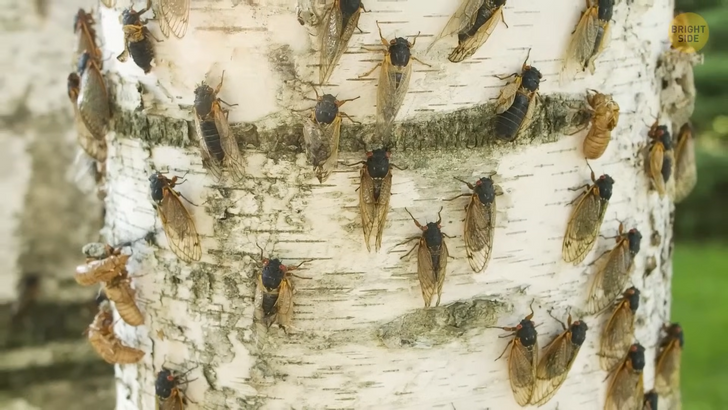
The awakening of cicadas is always a surprise for people. Any day, you can wake up to a loud noise outside. Cicadas gather in huge swarms, fly out into the streets, and cover cars, trees, and buildings. They chatter for weeks, and then silence comes. Cicadas disappear as suddenly as they appear.
The cicada’s sounds can be pleasant or harmful to your ears, depending on the species. It can be something melodic and captivating. When millions of cicadas click in the forest, it resembles the sound of a jet plane or a circular saw working. Some people can’t stand it and run away from the singing swarm. But many also say that cicadas make a pleasant sound that envelops you from all sides, which is a pretty unusual feeling.
They make this noise to attract breeding partners or to warn their families of danger. Perhaps they are just having fun. And the reason for such joy is their life cycle. Cicadas spend several years underground and then come out to make noise for the last several weeks of their lives. And what they do under the surface is one of the most exciting mysteries for scientists.
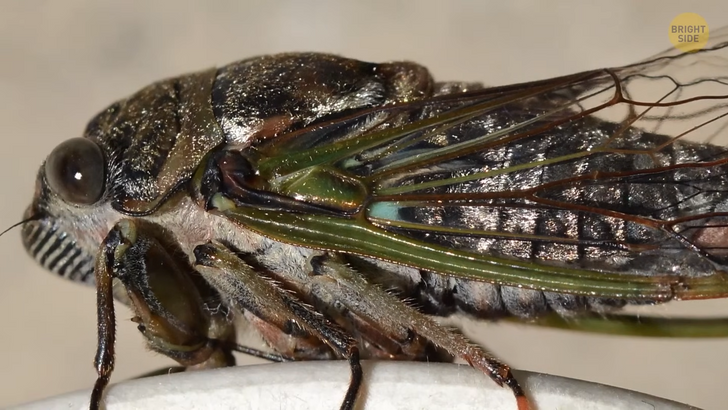
So, cicadas are physically strong insects with big eyes and unique wings. We’ll talk about their uniqueness later, but now, let’s figure out why these insects are so awesome. There are about three thousand species of cicadas, but they are all divided into two groups — annual and periodic ones.
Annual is a common type. You can meet them all over the world. They live from two to five years or longer and have a normal insect lifestyle. They fly, drink the sap of trees, and click. But periodic cicadas live only in North America, in the central and eastern regions of the USA.
They can disappear as a species off the face of the earth and then, a few years later, appear in a forest and make such noise that you can hear it from afar. Imagine walking in the woods, picking mushrooms and berries. And then, the soil begins to move, and hundreds of thousands of cicadas are flying out. They are everywhere, and they are very loud. But don’t worry, they’re not aggressive and won’t bite you.
The life cycle of these insects is divided into three parts — eggs, nymphs, and adults. At first, females lay several hundred eggs in different places. They leave their offspring near the ground on the branches of trees and brush. Then, after six to ten weeks, little nymphs hatch out of them, fall to the floor, and burrow into the soil. There, they munch on fluids from the roots of plants and grow.
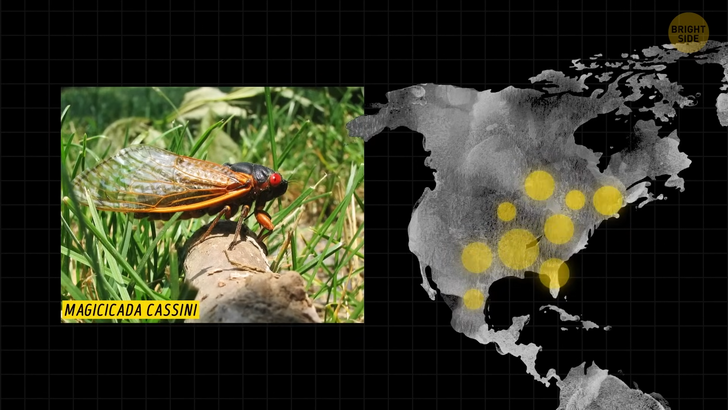
They spend thirteen or seventeen years in these underground tunnels, then molt their shells and come out. And they all do it at the same time. It’s as if someone gives them one order, and they drop everything to come to the surface simultaneously. And after they rise, they start to click.
Imagine spending more than ten years in a cramped, dark space and then going out into a bright, open world where you will live for several weeks. No wonder cicadas are chirping so loudly. Or they may have a great time underground and then decide to spend their retirement outdoors. Most likely, their appearance coincides with convenient natural conditions. They wait for the soil temperature to become comfortable for reproduction and come out. However, while the soil heats up and gets colder annually, cicadas come out once every thirteen or seventeen years.
Scientists can’t give an exact explanation for this, but it may be related to other animals. Cicadas are pretty defenseless and nutritious creatures. A swarm of millions of cicadas is a feast for many forest inhabitants. Owls and foxes like to eat them. Suppose the forest ecosystem gets used to the annual singing of cicadas. In that case, their enemies will quickly destroy the entire population of these insects. Therefore, cicadas come out when no one expects them. Perhaps they choose the moment when the population growth of owls and foxes is at the lowest level. To avoid meeting them, cicadas wait for several years.
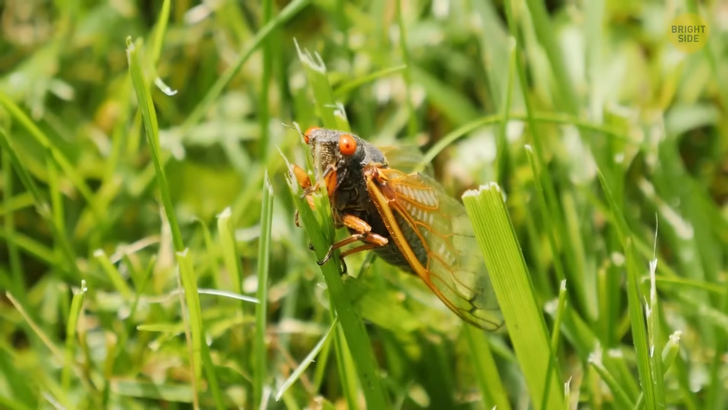
This version looks logical, but something doesn’t work in it. If cicadas fight for survival in such a way, then why don’t all species do it? Annual cicadas regularly appear in the forest and are an integral part of the ecosystem. They continue to exist despite the presence of many enemies. Why do periodic ones decide to hide? This is still unknown.
A massive swarm of cicadas resembles locusts, so many consider them pests. But unlike these crop eaters, cicadas only feed on the sap of trees. They won’t eat your corn, destroy your garden, and bite the leaves. Cicadas drink juice from branches and roots, and they do it quite rarely.
Yes, a million cicadas can damage trees because of their relative weight, but the damage they cause to people is not comparable to what locusts do. Besides, cicadas will rarely bother you. You can finish university and change several jobs, and the cicadas would come out only once during this time. And they also look pretty cute for insects. Their wings have beautiful patterns, and their eyes are so huge. However, they can still terrify you, especially if you meet a swarm of cicadas on your way.

Life underground seems safe, but even there, the cicadas have their antagonists. And the main one is a special kind of parasitic fungi that can penetrate the body of a cicada and slowly devour it. The fungus takes control of the body and turns the host into a living zombie. These parasites have also learned to change their life cycle, following the life cycle of cicadas. That is, the fungus remains in the body of an insect for a long time and does nothing. And then, when the cicada comes to the surface, the parasite wakes up and begins to spoil its life. It feeds on the host’s body and forces it to spread the fungus spores throughout the swarm to infect future generations.
Another type of fungus doesn’t wait for the cicadas to crawl to the surface. These parasites can cause infected insects to get out of the ground ahead of time, crawl up tree branches, and scatter spores. Sometimes fungi grow out of cicadas while they are still underground. It seems that cicadas won’t survive with such dangerous enemies, but nature has found a balance.
Some types of fungi don’t destroy their carriers. They live in symbiosis with cicadas. The parasite gets a home, and the cicada probably gets nutrients from the fungus. For scientists, this is a unique case when fungi abandon their parasitic lifestyle.
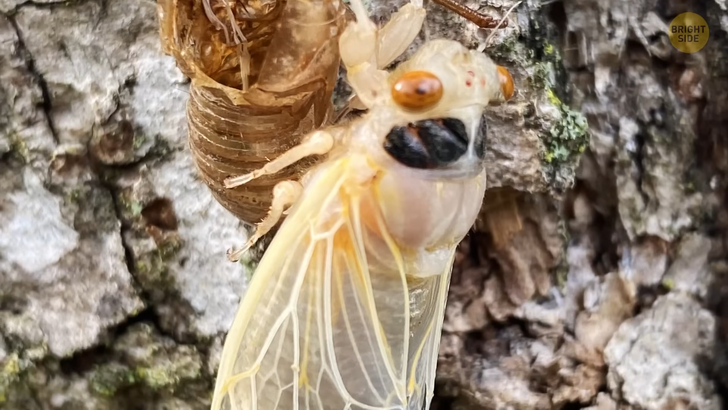
With each emergence to the surface, the cicadas become bigger in size. This happens because large cities emit a lot of heat and nutrients into the air, warming the area by several degrees. This contributes to an increase in cicadas’ size. But the growth only applies to those insects that live near cities. Cicadas hiding in rural areas with colder temperatures retain the same size. The uniqueness of cicadas is not only in their life development but also in their anatomy. When insects become adults, their wings get covered with tiny nanopillars that can repel water, destroy bacteria, and self-clean.
Doctors, chemists, and engineers want to use the properties of cicada wings to develop new technologies in different fields. A coating with the cicadas’ nanopillars can help people create new medicines. Engineers want to use self-cleaning surfaces of the wings without glare as coatings for solar panels and other high-tech developments. So, yeah, cicadas actually help us a lot!











